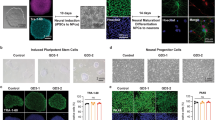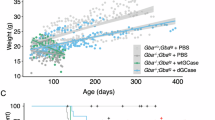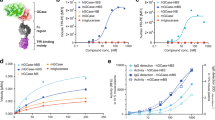Abstract
Gaucher disease (GD) is an autosomal recessive lysosomal storage disorder caused by the deficiency of glucocerebrosidase enzyme activity. Clinical phenotypes of GD are categorized into three groups: (i) non-neuronopathic GD (type 1), (ii) acute neuronopathic GD (type 2) and (iii) subacute neuronopathic GD (type 3). The high-risk screening of neuronopathic GD has been performed using an enzymatic assay on the dried blood spot (DBS) samples. We enrolled a total of 102 individuals (47 females, 55 males; 0–57 years old; median age 10.5 years) with various neurological symptoms. We detected two patients with very low enzyme activity and they were diagnosed with the disease by using glucocerebrosidase gene analysis. Patient 1 was found to be compound heterozygous for the p.R159W/p.R170C locus and patient 2 was found to harbor two mutations at the IVS7+1G>T (c.999+1G>T) and p.L483P sites. This simple screening protocol using DBS samples is useful for early diagnosis of GD in high-risk and underdiagnosed patients suffering from various neurological symptoms.
Similar content being viewed by others
Log in or create a free account to read this content
Gain free access to this article, as well as selected content from this journal and more on nature.com
or
References
Platt FM. Sphingolipid lysosomal storage disorders. Nature. 2014;510:68–75.
Charrow J, Andersson HC, Kaplan P, Kolodny EH, Mistry P, Pastores G, et al. The Gaucher registry: demographics and disease characteristics of 1698 patients with Gaucher disease. Arch Intern Med. 2000;160:2835–43.
Tajima A, Yokoi T, Ariga M, Ito T, Kaneshiro E, Eto Y, et al. Clinical and genetic study of Japanese patients with type 3 Gaucher disease. Mol Genet Metab. 2009;97:272–7.
Motta I, Filocamo M, Poggiali E, Stroppiano M, Dragani A, et al. A multicenter observational study for early diagnosis of Gaucher disease in patients with splenomegaly and/or thrombocytopenia. Eur J Haematol. 2016;96:352–9.
Chamoles NA, Blanco M, Gaggioli D, Casentini C. Gaucher and Niemann-Pick disease-enzymatic diagnosis in dried blood spots on filter paper: retrospective diagnosis in newborn-screening cards. Clin Chim Acta. 2002;317:191–7.
Yoshida S, Kido J, Matsumoto S, Momosaki K, Mitsubuchi H, Shimazu T, et al. Prenatal diagnosis of Gaucher disease using next-generation sequencing. Pediatr Int. 2016;58:946–9.
Chabas A, Cormand B, Balcells S, Gonzalez-Duarte R, Casanova C, Colomer J, et al. Neuronopathic and non-neuronopathic presentation of Gaucher disease in patients with the third most common mutation (D409H) in Spain. J Inherit Metab Dis. 1996;19:798–800.
Sinclair G, Choy FYM, Humphries L. A novel complex allele and two new point mutations in type 2 (acute neuronopathic) Gaucher disease. Blood Cells Mol Dis. 1998;24:420–7.
Tsuji S, Choudary PV, Martin BM, Stubblefield BK, Mayor JA, Barranger JA, et al. A mutation in the glucocerebrosidase gene in neuronopathic Gaucher’s disease. N Engl J Med. 1987;316:570–5.
Mignot C, Gelot A, Bessières B, Daffos F, Voyer M, Menez F, et al. Perinatal-lethal Gaucher Disease. Am J Med Genet A. 2003;120A:338–44.
El-Beshlawy A, Tylki-Szymanska A, Vellodi A, Belmatoug N, Grabowski GA, Kolodny EH, et al. Long-term hematological, visceral, and growth outcomes in children with Gaucher disease type 3 treated with imiglucerase in the International Collaborative Gaucher Group Gaucher Registry. Mol Genet Metab. 2017;120:47–56.
Narita A, Shirai K, Shinji I, Matsuda A, Ishihara A, Matsushita K, et al. Ambroxol chaperone therapy for neuronopathic Gaucher disease: a pilot study. Ann Clin Transl Neurol. 2016;3:200–15.
Acknowledgements
We thank Fumiko Nozaki, Naomi Yano, and Matsumi Harada of Kumamoto University for their excellent technical support. This study was supported by a grant from the Ministry of Health, Labor and Welfare of Japan; a grant-in-aid for scientific research from the Ministry of Education, Culture, Sports, Science and Technology and a research grant from Shire Pharmaceuticals. The institutions that provided financial support had not played a role in the data collection or analysis.
Author information
Authors and Affiliations
Corresponding author
Ethics declarations
Conflict of interest
The authors declare that they have no conflict of interest.
Rights and permissions
About this article
Cite this article
Momosaki, K., Kido, J., Matsumoto, S. et al. High-risk screening for Gaucher disease in patients with neurological symptoms. J Hum Genet 63, 717–721 (2018). https://doi.org/10.1038/s10038-018-0438-7
Received:
Revised:
Accepted:
Published:
Issue date:
DOI: https://doi.org/10.1038/s10038-018-0438-7
This article is cited by
-
A review of type 3 Gaucher disease: unique neurological manifestations and advances in treatment
Acta Neurologica Belgica (2024)
-
High-risk screening for Anderson–Fabry disease in patients with cardiac, renal, or neurological manifestations
Journal of Human Genetics (2019)



